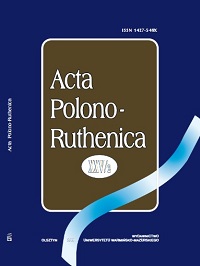Poezja Natalii Liwyckiej-Chołodnej w tłumaczeniach Józefa Łobodowskiego
Natalya Lyvitska-Kholodna’s poetry in Józef Łobodowski’s translations
Author(s): Anna Choma-SuwałaSubject(s): Language and Literature Studies, Studies of Literature, Ukrainian Literature, Philology, Translation Studies
Published by: Wydawnictwo Uniwersytetu Warmińsko-Mazurskiego w Olsztynie
Keywords: Natalya Livytska-Kholodna; Józef Łobodowski; poetry;translation;
Summary/Abstract: This paper provides a comparative analysis of Polish and Russian carolling activity, which may be considered as a symbolic celebration of “tricksteriada”. Descriptions of carolling customs cultivated in the 19th- and at the beginning of the 20th century, primarily in ethnographic studies, were used as the source material. The issue mentioned above, to date, has not been studied, except quite limited comments concerning the “trickster” nature of masqueraders and their plays. Folk culture, i.e. a syncretic creation, was formed by pagan and Christian elements. In the context of the subject of this paper, rituals such as Christmas and New Year’s carolling prove its Slavic origin. The “supernatural visitors”, dressed as animals and anthropomorphic characters, violate cultural taboos. During carnival the order is reversed and provocative behaviour is acceptable. The carollers, in their role as traveling actors, seem to impersonate jesters in plays.The aim of the current article is to present the poetry of Natalya Livyt-ska-Kholodna in pre-war translations of Józef Łobodowski. The main objective is to indicate the premises which guided the translator in selecting poems, to demonstrate the characteristics of his poetic skills, as well as to discuss his translations. Although Natalya Livytska-Kholodna (1902–2005) is included in the so-called “Prague school”, she lived in Poland for over 20 years. Two volumes of her poetry were published in Warsaw: Вогонь і попіл (Fire and Ash, 1934)and Сім літер (Seven Letters, 1937). In spite of that, her literary achievements were almost entirely unknown to Polish readers in the interwar period. A few translations of her early poetry were published in the years 1934–1938 in the monthly “Sygnały”, “Biuletyn Polsko-Ukraiński”(“Polish-Ukrainian Bulletin”) and “Wołyń”magazine. Their authors were Tadeusz Hollender and Józef Łobodowski, with the latter publishing three translations: На розквітлі акації грона (Silver Moon Enveloped the Acacia), На розпуттях (Rue Racine) and На могилі (Over the Grave). The poet from Lublin chose works which were close to his own poetry and political views. The translations discussed here exemplify dynamic equivalence and are characterised by Łobodowski’s energy and personal involvement. He draws attention to semantic adequacy, but he does not refrain from poetizing the text. His translations include many elements aimed at stimulating the imagination of Polish readers.
Journal: Acta Polono-Ruthenica
- Issue Year: 2/2020
- Issue No: XXV
- Page Range: 137-154
- Page Count: 18
- Language: Polish

